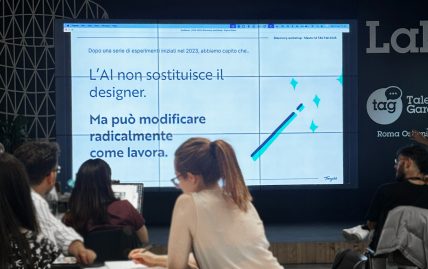Thinking
Using AI to create experiences, not just features
AI is not just an automation engine - it’s an opportunity to rethink how people interact with digital products. What does it mean to design experiences instead of just features?

Two weeks ago, we had the opportunity to spend a couple of afternoons with Josh Clark and Veronika Kindred from Big Medium, discussing the relationship between AI and design, the future of digital product development, and diving deeper into what they define as Sentient Design.
Josh and Veronika have done an exceptional job of researching, systematizing, and synthesizing these concepts, which they have been sharing through webinars, workshops, and articles. But beyond the label, what are we really talking about when we talk about sentient design?

Understanding context and intent
Thanks to AI, we can design “sentient” interfaces and products—systems capable of decoding and understanding user context and intent. From multi-modal inputs to natural language queries and contextual data analysis, we now have access to a vast amount of information to generate outputs that respond in a personalized rather than generic way.
Large language models (LLMs) are particularly effective at recognizing language patterns, making them valuable for understanding user intent and shaping the next interaction accordingly.
Prioritizing user goals, understanding intent and context is an integral part of the value AI generates—both for users and businesses. At the same time, this understanding helps establish trust and reliability in AI-driven systems, ensuring they respond appropriately to real needs.
Radically adaptive experiences
By leveraging this understanding of intent and context, we can deliver real-time, on-demand interfaces that are highly adaptive. In the past, users had to adapt to the system. Today, we have the ability to adapt the system’s output to the user.
That said, one fundamental principle of design remains unchanged: interfaces must still align with users’ mental models. AI should not replace this approach but enhance it, creating tailored experiences that match user expectations.
It’s within this definition of radically adaptive experiences that the concept of Bespoke UI emerges—interfaces that are dynamically assembled from existing templates and components (if you’re interested in this topic, we discussed it here) based on user intent.

"Magical" experiences through divergent thinking
One of the most interesting challenges when designing with AI is not technological limitations, but limitations in our own imagination. Josh posed a thought-provoking question: what if, instead of starting with technology, we started with the experience we want to create?
Instead of asking, “How can we use AI?”, we should ask, “What kind of experience do we want to offer?”.
Technology comes only after we’ve answered that.
This approach—deeply rooted in design fundamentals but now seen through a new lens—allows us to imagine new, unconventional solutions, rather than simply following existing patterns.
This is where I’d like to take a detour into complexity theory and reference some of the conversations we’ve had at Tangible with Alessandro Cravera over the years.
In predictable, structured environments—like design and development before AI—best practices were valuable and meaningful.
However, in an increasingly complex landscape, where predictability decreases, real-time responses are required, and control diminishes, we enter the realm of emerging practices. When it comes to AI-powered interfaces and interactions, we are firmly in this new landscape—defining emerging practices instead of applying best practices.
AI as an enabler of experiences, not just a tool
This is the real shift in perspective: we must stop viewing AI as just a tool to be added to products. Instead, we should think of it as a foundational material—an ingredient that can reshape how products are designed and experienced.
This is where the concept of "casual intelligence" comes in: the idea of embedding small, intelligent, algorithmic elements into existing products and services—adding automation, personalization, and contextualization.
This is particularly relevant given today’s AI hype. While AI-native products attract attention, incremental innovation is often more realistic than radical change—especially in mature, complex digital ecosystems. Casual intelligence offers a practical, short-term way for large digital platforms to enhance user experience without overhauling their systems entirely.

How does Tangible approach these scenarios?
Whether designing something new or embedding casual intelligence into existing products and services, we are building the tools and methods to guide our clients through this transformation.
In our next post, we will outline our approach to AI in design projects. If you’d like to learn more in the meantime, let’s talk.
______


